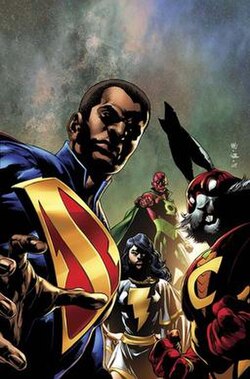"In Which We Burn"
The Multiversity: Pax Americana #1 (January 2015), Written by Grant Morrison; Art by Frank Quitley
Last week saw the release of the fourth installment of Morrison's Multiversity storyline.
Pax Americana is perhaps the most ambitious issue to date, being a refiguring of/homage to
Watchmen, and either a commentary on deconstruction and comic book violence or the essentialness of violence to American cultural--or possibly both. So check it out.
All that aside, the issue takes place on Earth-4, which is essentially (or possibly exactly) the same as Earth-4 (first appearing in
52 week 52 in 2007), the home of Captain Atom, the "Quantum Superman" that appeared in
Final Crisis: Superman Beyond. In other words, it's a mixture of the Pre-Crisis Earth-Four (home of the characters DC acquired from
Charlton Comics) and the Earth of
Watchmen (characters inspired by the Charlton characters--well, after they were inspired by the Archie/MLJ characters). If that's a bit confusing, there is some background
here.
Blue Beetle (Earth-4)
This Blue Beetle is Ted Kord, Earth-4's version of Charlton's second Blue Beetle, who first appeared in
Captain Atom #83 (1966). There is mention in this issue of Dan Garrett, who shares a name and probably more with Charlton's first Blue Beetle--who they had purchased and revamped from Fox Comics. The original version of that character (and the likely inspiration of Pax Americana's Dan Garret) first appeared in
Mystery Men Comics #1 (1939). Both these Blue Beetles have analogs in the first and second Nite Owls in
Watchmen. The Question's accusation of the Beetle's impotence in this issue is a specific reference to Nite Owl.
Captain Atom (Earth-4)
First Appearance: Final Crisis: Superman Beyond #1 (2008)
The original Captain Atom first appeared in
Space Adventures #33 (March 1960). Both that one and this one are Allen Adam, who gained super-powers after being "atomized," then reforming with atomic powers. This Atom's expanded consciousness, almost godlike power, and blue skin are borrowed from Dr. Manhattan in
Watchmen.
Nightshade (Earth-4)
Eve Eden is the daughter of the Vice President and a superheroine. The original Charlton Nightshade first appeared in
Captain Atom #82 (1966) was the daughter of a U.S. senator and a visitor from another dimension with the power to manipulate shadows. An otherworldly origin for Eve's mother is mentioned in this issue, but her veracity is questioned by both Eve and her father, and her mother is portrayed as suffering from dementia, at least at the time of the story. The Nightshade stand-in in Watchmen is Silk Spectre, though she is not as close an analog as the male characters.
Peacemaker (Earth-4)
The original Charlton Peacemaker (a man who "loves peace so much he's willing to fight for it") first appeared in
Fightin' 5 #40 (November 1966). The loose Peacemaker analog in
Watchmen is the Comedian. Dialog in
Watchmen hints that the Comedian assassinated John F. Kennedy, a parallel to the Peacemaker's actions here, though in a very different context. Unlike the cynical Comedian, the Peacemaker of this story seems to be a well-meaning idealist.
The Question (Earth-4)
One of a couple of similar masked and fedora-ed vigilantes created by Steve Ditko, the Charlton Question first appeared in
Blue Beetle #1 (1967). Rorshach in
Watchmen was inspired the Question and his non-Code approved doppelganger
Mr. A. While taking a role in the story similar to Rorschach's,
Pax Americana's Question moves beyond the the black-and-white moral reasoning of Mr. A and Rorschach and espouses of 8 color spectrum theory of moral development (probably from
here). He is, however, as ruthless as both of those characters.
Yellowjacket
This is actually Yellowjacket's first DC Universe appearance in any version. The original Yellowjacket was Charlton's very first superhero character, debuting in
Yellowjacket Comics #1 (September 1944). That Yellowjacket was Vince Harley, crime writer. This one is Vince Harley, comic book writer. He has no direct specific Watchmen analog.



%2B001-047.jpg)

%2B001-036.jpg)


%2B001-048-earth-35.jpg)

%2B001-030-Earth-6.jpg)
%2B001-058.jpg)
%2B001-032.jpg)








%2B001-049-Earth-37.jpg)









.jpg)





